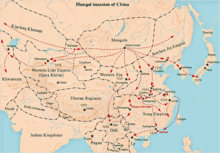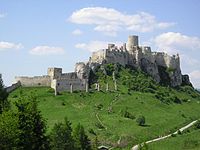Mongol invasions and conquests
| Mongol invasions and conquests | |||||
|---|---|---|---|---|---|
 Expansion of the Mongol Empire 1206–94 | |||||
| |||||
| Casualties and losses | |||||
| Total dead: 20–57 million[1][2][3] | |||||
The Mongol invasions and conquests took place during the 13th and 14th centuries, creating history's largest contiguous empire, the
Overview
The Mongol Empire developed in the course of the 13th century through a series of victorious campaigns throughout Eurasia. At its height, it stretched from the
As the Mongol Empire began to
History and outcomes
Central Asia
Large areas of Islamic Central Asia and northeastern Persia were seriously depopulated,[9] as every city or town that resisted the Mongols was destroyed. Each soldier was given a quota of enemies to execute according to circumstances. For example, after the conquest of Urgench, each Mongol warrior – in an army of perhaps two tumens (20,000 troops) – was required to execute 24 people, or nearly half a million people per said army.[10]
Against the
During the Mongol attack on the Middle East ruled by the Mamluk Sultanate, most of the Mamluk military was composed of Kipchaks and the Golden Horde's supply of Kipchak fighters replenished the Mamluk armies and helped them fight off the Mongols.[11]
Hungary became a refuge for fleeing Cumans.[14]
The decentralized, stateless Kipchaks only converted to Islam after the Mongol conquest, unlike the centralized Karakhanid entity comprising the Yaghma, Qarluqs, and Oghuz who converted earlier to world religions.[15]
The Mongol conquest of the Kipchaks led to a merged society with a Mongol ruling class over a Kipchak-speaking populace which came to be known as Tatar, and which eventually absorbed Armenians, Italians, Greeks, and Crimean Goths in Crimea, the origin of the current Crimean Tatars.[16]
West Asia
The Mongols conquered, by battle or voluntary surrender, the areas of present-day Iran, Iraq, the
East Asia

The Mongols' greatest triumph was when Kublai Khan established the Yuan dynasty in China in 1271. The dynasty created a "Han Army" (漢軍) out of defected Jin troops and an army of defected Song troops called the "Newly Submitted Army" (新附軍).[18]
The Mongol force which invaded southern China was far greater than the force they sent to invade the Middle East in 1256.[19]
The Yuan dynasty established the top-level government agency
North Asia
By 1206,
Western Siberia came under the Golden Horde.[22] The descendants of Orda Khan, the eldest son of Jochi, directly ruled the area. In the swamps of western Siberia, dog sled Yam stations were set up to facilitate collection of tribute.
In 1270,
Eastern and Central Europe


The Mongols invaded and destroyed
They [the Mongols] attacked Russia, where they made great havoc, destroying cities and fortresses and slaughtering men; and they laid siege to Kiev, the capital of Russia; after they had besieged the city for a long time, they took it and put the inhabitants to death. When we were journeying through that land we came across countless skulls and bones of dead men lying about on the ground. Kiev had been a very large and thickly populated town, but now it has been reduced almost to nothing, for there are at the present time scarce two hundred houses there and the inhabitants are kept in complete slavery.[26]
The Mongol invasions displaced populations on a scale never seen before in central Asia or eastern Europe. Word of the Mongol hordes' approach spread terror and panic.[27] The violent character of the invasions acted as a catalyst for further violence between Europe's elites and sparked additional conflicts. The increase in violence in the affected eastern European regions correlates with a decrease in the elite's numerical skills, and has been postulated as a root of the Great Divergence.[28]
South Asia
From 1221 to 1327, the Mongol Empire launched several invasions into the
Southeast Asia
Kublai Khan's Yuan dynasty invaded Burma between 1277 and 1287, resulting in the capitulation and disintegration of the Pagan Kingdom. However, the invasion of 1301 was repulsed by the Burmese Myinsaing Kingdom. The Mongol invasions of Vietnam (Đại Việt) and Java resulted in defeat for the Mongols, although much of Southeast Asia agreed to pay tribute to avoid further bloodshed.[29][30][31][32][33][34]
The Mongol invasions played an indirect role in the establishment of major Tai states in the region by recently migrated Tais, who originally came from Southern China, in the early centuries of the second millennium.[35] Major Tai states such as Lan Na, Sukhothai, and Lan Xang appeared around this time.
Death toll
Due to the lack of contemporary records, estimates of the violence associated with the Mongol conquests vary considerably.[36] Not including the mortality from the Plague in Europe, West Asia, or China[37] it is possible that between 20 and 57 million people were killed between 1206 and 1405 during the various campaigns of Genghis Khan, Kublai Khan, and Timur.[38][39][40] The havoc included battles, sieges,[41] early biological warfare,[42] and massacres.[43][44]
See also
- Destruction under the Mongol Empire
- Division of the Mongol Empire
- List of wars and anthropogenic disasters by death toll
- Lists of battles of the Mongol invasion of Europe
- Mongol invasion of Europe
- Mongol military tactics and organization
- Political divisions and vassals of the Mongol Empire
- Timeline of the Mongol Empire
References
Notes
- ^ "Of necessity, the Mongols did most of their conquering and plundering during the warmer seasons, when there was sufficient grass for their herds. [...] Fuelled by grass, the Mongol empire could be described as solar-powered; it was an empire of the land. Later empires, such as the British, moved by ship and were wind-powered, empires of the sea. The American empire, if it is an empire, runs on oil and is an empire of the air."[6]
- ^ "This called for the employment of engineers to engaged in mining operations, to build siege engines and artillery, and to concoct and use incendiary and explosive devices. For instance, Hulagu, who led Mongol forces into the Middle East during the second wave of the invasions in 1250, had with him a thousand squads of engineers, evidently of north Chinese (or perhaps Khitan) provenance."[17]
References
- OCLC 8159945824.
- ISBN 9780140510768.
- ISBN 0-12-765660-X
- ^ "What Was the Deadliest War in History?". WorldAtlas. 10 September 2018. Archived from the original on 2019-10-09. Retrieved 2019-02-04.
- ^ White, M. (2011). Atrocities: The 100 deadliest episodes in human history. WW Norton & Company. p270.
- ^ a b "Invaders". The New Yorker. 18 April 2005. Archived from the original on 12 June 2018. Retrieved 12 February 2022.
- PMID 24616521.
- JSTOR 604669.
- ^ World Timelines – Western Asia – AD 1250–1500 Later Islamic Archived 2010-12-02 at the Wayback Machine
- ^ "Central Asian world cities Archived 2012-01-18 at the Wayback Machine", University of Washington.
- ^ S2CID 162439703.
- JSTOR 41933117.
- ISBN 978-0-520-04562-0. Archivedfrom the original on 2024-01-01. Retrieved 2020-11-01.
- JSTOR 3014440.
- JSTOR 41928154.
- S2CID 162929705.
- ISBN 978-0-415-96690-0. Archivedfrom the original on 2024-01-01. Retrieved 2011-11-28.
- ^ Hucker 1985 Archived 2015-09-10 at the Wayback Machine, p. 66.
- JSTOR 606298.
- The Secret History of the Mongols, ch.V
- ^ C.P.Atwood-Encyclopedia of Mongolia and the Mongol Empire, p. 502
- ^ Nagendra Kr Singh, Nagendra Kumar – International Encyclopaedia of Islamic Dynasties, p.271
- ^ History of Yuan 《 元史 》,
- ^ C.P.Atwood-Encyclopedia of Mongolia and the Mongol Empire, p.503
- ^ "BBC Russia Timeline". BBC News. 2012-03-06. Archived from the original on 2018-03-18. Retrieved 2018-03-31.
- ^ The Destruction of Kiev Archived 2011-04-27 at the Wayback Machine
- ISBN 9780742567658. Archivedfrom the original on 2023-07-29. Retrieved 2015-06-20.
- S2CID 219040903.
- ^ Taylor 2013 Archived 2023-04-13 at the Wayback Machine, pp. 103, 120.
- ^ ed. Hall 2008 Archived 2016-10-22 at archive.today, p. 159 Archived 2023-04-06 at the Wayback Machine.
- ISBN 9780231511100. Archivedfrom the original on 1 January 2024. Retrieved 1 November 2020 – via Google Books.
- ^ Gunn 2011 Archived 2023-04-06 at the Wayback Machine, p. 112.
- ISBN 9780684189017. Archivedfrom the original on 1 January 2024. Retrieved 4 June 2020 – via Google Books.
- ^ Woodside 1971 Archived 2023-04-05 at the Wayback Machine, p. 8.
- ISBN 978-0521800860.
- ^ "Twentieth Century Atlas – Historical Body Count". necrometrics.com. Archived from the original on 2022-01-20. Retrieved 2019-02-04.
- ISBN 978-92-64-03763-2.[page needed]
- OCLC 8159945824.
- ISBN 9780140510768.
- ISBN 0-12-765660-X
- ^ "Mongol Siege of Kaifeng | Summary". Encyclopedia Britannica. Archived from the original on 2022-01-14. Retrieved 2019-02-04.
- PMID 12194776.
- ProQuest 1308651973.
- ^ Halperin, C. J. (1987). Russia and the Golden Horde: the Mongol impact on medieval Russian history (Vol. 445). Indiana University Press.
Further reading
- Boyle, J.A. The Mongol World Enterprise, 1206–1370 (London 1977)[ISBN missing]
- Hildinger, Erik. Warriors of the Steppe: A Military History of Central Asia, 500 B.C. to A.D. 1700
- May, Timothy. The Mongol Conquests in World History (London: Reaktion Books, 2011) online review; excerpt and text search
- Morgan, David. The Mongols (2nd ed. 2007)
- Rossabi, Morris. The Mongols: A Very Short Introduction (Oxford University Press, 2012)
- Saunders, J. J. The History of the Mongol Conquests (2001) excerpt and text search
- Srodecki, Paul. Fighting the ‘Eastern Plague'. Anti-Mongol Crusade Ventures in the Thirteenth Century. In: The Expansion of the Faith. Crusading on the Frontiers of Latin Christendom in the High Middle Ages, ed. Paul Srodecki and Norbert Kersken (Turnhout: Brepols 2022), ISBN 978-2-503-58880-3, pp. 303–327.
- Turnbull, Stephen. Genghis Khan and the Mongol Conquests 1190–1400 (2003) excerpt and text search
- Bayarsaikhan Dashdondog. The Mongols and the Armenians (1220–1335). BRILL (2010)
Primary sources
- Rossabi, Morris. The Mongols and Global History: A Norton Documents Reader (2011)
